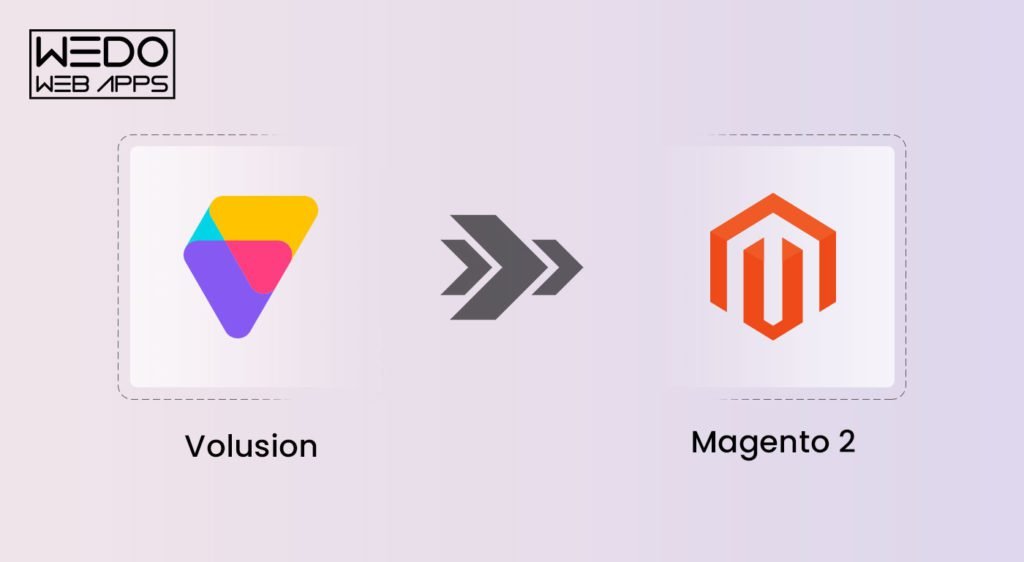15 Mar, 2023 | Magento development
Volusion to Magento 2 Migration: Most Detailed Guide

Stage 1: Preparing for the Volusion to Magento Migration Process
Step 1: Evaluating the current Volusion store and identifying potential issues to address during migration.
Migrating from Volusion to Magento 2 is a complex process that requires careful planning and execution. Before you start the migration, it's important to evaluate your current Volusion store and identify any potential issues that may arise during the migration process. After discussing with various users, we found some of the major problems in the process like data files migration, losing product categories, and altered import settings.Step 2: Evaluate Magento 2 Store hosting provider
Hosting and server have a direct impact on your eCommerce store’s performance and that’s why you need to choose one which can manage your prevailing traffic with respect to Magento 2 theme.Step 3: Select required extensions and integrations
The next step involves picking up highly-functional extensions and integrations which can give you better control for your new store like payment gateways, shipping providers, and marketing tools.
Stage 2: Data Migration Process
Step 1: Export Data From Volusion And Import to Magento 2
Data migration process is a crucial step as you need to hire Magento migration experts to export data from Volusion and import to Magento 2 without any data loss. Doing this without any tool or experts can be complex owing to the fact that both Volusion and Magento 2 are based on different data structures and formats.Step 2: Ensuring Data Accuracy And Addressing Any Issues That Arise During The Migration Process.
Before you begin the data migration process, ensuring data accuracy is important. This involves carefully reviewing all data to ensure it is complete and accurate. You may need to clean up data and resolve any data inconsistencies before importing it into Magento 2.Stage 3: Magento 2 Store Customization
Step 1: As per the new store’s design and layout, you need to work on optimizing the design to ensure higher user experience.
So, if you are planning to customize your Magento 2 store you must work on making your store easy to navigate, clear CTA buttons, mobile responsiveness and optimization.Step 2: Magento 2 Extensions and Integrations Installation
Added functionalities come with Magento 2 and for that you can look out for various extensions and integrations available. With extensions you can enable various payment gateways, shipping functionalities, tools for data analysis. Ensure to check reviews of these tools as they can make your store slow down in terms of loading or rendering.Stage 4: Test and Launch Magento Store
Step 1: Find bugs after frontend and backend testing
They say, the more you test your Magento 2 store the better you can make it. And that’s true as when you test, you get to know if all the functions are performing well and as intended. In this, you should also do a small market test within your team and take feedback related to user experience and make sure all processes are optimized.Step 2: Launch your Magento eCommerce store
After all debugging and testing, it's time to follow some of the right practices to launch your Magento store and ensure you pick up a day on which your site has maximum traffic. Also, before launching don’t forget to take the final backup of your store so that you have a copy. We understand you have already tested your store, but it’s crucial to re-test so that all the data is intact and functions like payment gateways are working fine. Once everything is set, it’s time to plan an email shootout with some attractive offer - this will help in two ways. One, your audience knows about the new store launch (if design is changed), and two offers will entice them to shop and you can check if order processing is working fine.Understanding the Differences Between Volusion Ecommerce and Magento 2
It's important to understand the key differences between Volusion and Magento 2. Volusion is an all-in-one e-commerce platform that provides businesses with everything they need to launch and manage an online store. But, Magento 2 is a more flexible and powerful e-commerce platform when your business eCommerce store demands complex features and functionalities be it extensions or tools to manage ever-growing product catalogs. While Volusion is a good option for small to medium-sized companies with comparatively simple e-commerce needs, Magento 2 is better suited for companies with more extensive catalogs, complex pricing structures, and advanced customization needs. Furthermore, Magento 2 is an open-source platform, giving companies more control over the features and appearance of their online stores.Reasons why businesses should consider Volusion Store to Magento 2 Store migration:
1. Scalability 2. Customization 3. Mobile Optimization 4. Better SEO 5. Better Support So, if you are a business which is planning to scale your eCommerce business, migrating to Magento 2 from Volusion is the most suitable option. Read also about Handy Magento 2 Migration Checklist For Your E-commerce Business
Final Thoughts
When it comes to migrating from Volusion to Magento 2, careful planning and execution are crucial for a successful transition. Therefore, it's important to work with experienced developers who can guide you through the process and ensure that everything is set up correctly, from data migration to SEO optimization. One of the most important considerations is ensuring that your site is redirected correctly, which can help preserve your existing SEO rankings and prevent any traffic loss. Ultimately, migrating from Volusion to Magento 2 can offer significant benefits for your online store, including increased flexibility, scalability, and improved performance and data security. However, careful planning and execution are critical to ensuring a smooth transition and making the most of these benefits. By working with Magento 1 to Magento 2 migration service from WEDOWEBAPPS LLC and taking the time to plan and execute the migration process properly, you can ensure that your online store is set up for success in the long run.Frequently Asked Questions
It can be a few weeks to a few months as the Migration from Volusion to Magento 2 duration has a direct relation with the complexity of your data. It’s not just about migration, but also about a smooth migration which has no data loss and better store optimization.
Yes, you surely need help when you plan to migrate from Volusion to Magento 2 as it needs a lot of checks. Carefully plan and prepare for the migration to ensure a seamless transition with WEDOWEBAPPS as we help you with services like Volusion to Magento and Magento 1 To Magento 2 Migration Service. In Magento 1 To Magento 2 Migration Service or Volusion to Magento migration, we ensure you have zero data loss, or other SEO related issues like broken links and page errors. Along with this, you get ongoing support throughout the migration process. While working with dedicated Magento Migration expert service providers may require additional investment, it can ultimately save you time, money, and headaches in the long run by ensuring a smooth and successful migration process.
While it's possible to migrate store data from Volusion to Magento 2, it's important to carefully review and clean up your data to ensure accuracy and avoid data loss. Additionally, it's important to select the right tools and resources to simplify the migration process and minimize the risk of data loss.
Yes, it's possible to migrate your custom design and theme from Volusion to Magento 2, but it can be a complex and time-consuming process. The design and theme of your online store may need to be rebuilt or modified to ensure compatibility with Magento 2, and there may be some differences in the way that design elements are managed and configured. Therefore, working with experienced developers who can guide you through the process and ensure a seamless transition is important.
The cost and timeframe for PSD to Drupal/Magento conversion can vary depending on factors such as the complexity of the design, the number of pages, the desired functionality, and the service provider's rates. It is best to discuss your specific requirements with the service provider to get an accurate estimate and timeframe for your project.

